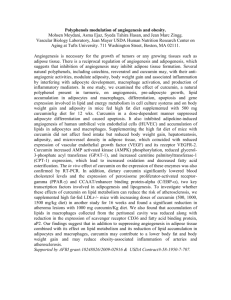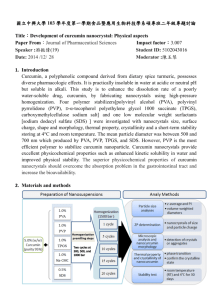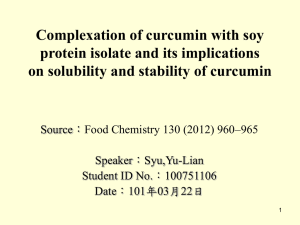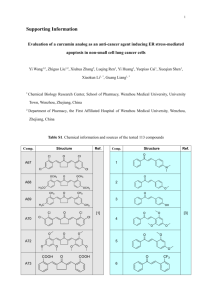Current Research Journal of Biological Sciences 4(1): 60-64, 2012 ISSN: 2041-0778
advertisement
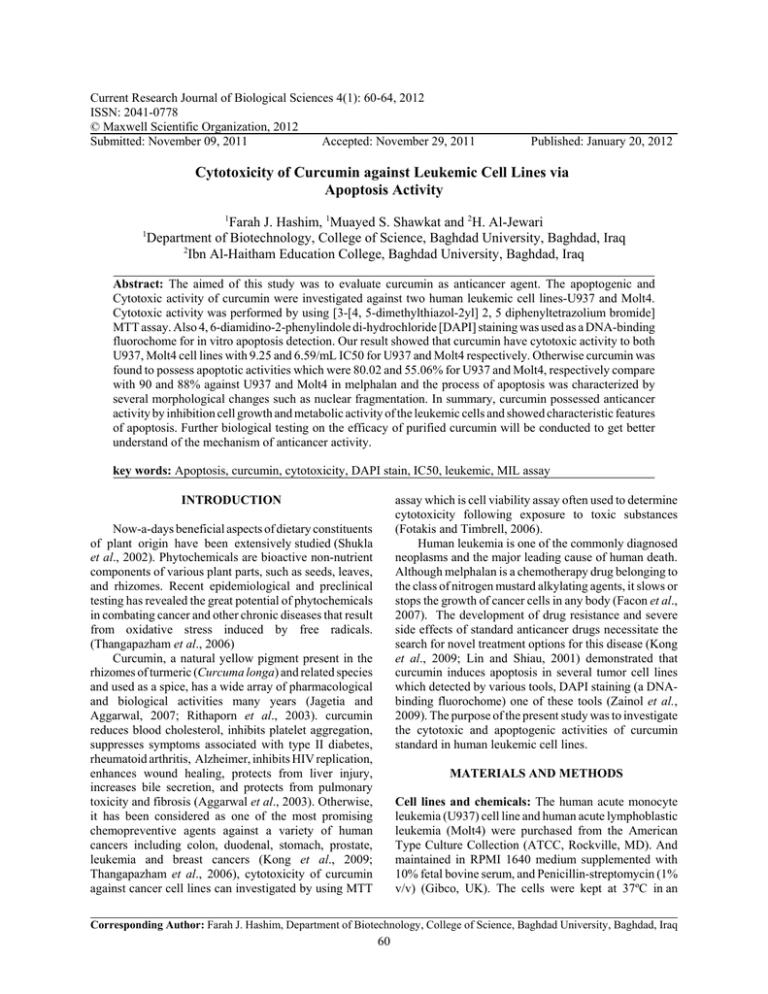
Current Research Journal of Biological Sciences 4(1): 60-64, 2012 ISSN: 2041-0778 © Maxwell Scientific Organization, 2012 Submitted: November 09, 2011 Accepted: November 29, 2011 Published: January 20, 2012 Cytotoxicity of Curcumin against Leukemic Cell Lines via Apoptosis Activity 1 1 Farah J. Hashim, 1Muayed S. Shawkat and 2H. Al-Jewari Department of Biotechnology, College of Science, Baghdad University, Baghdad, Iraq 2 Ibn Al-Haitham Education College, Baghdad University, Baghdad, Iraq Abstract: The aimed of this study was to evaluate curcumin as anticancer agent. The apoptogenic and Cytotoxic activity of curcumin were investigated against two human leukemic cell lines-U937 and Molt4. Cytotoxic activity was performed by using [3-[4, 5-dimethylthiazol-2yl] 2, 5 diphenyltetrazolium bromide] MTT assay. Also 4, 6-diamidino-2-phenylindole di-hydrochloride [DAPI] staining was used as a DNA-binding fluorochome for in vitro apoptosis detection. Our result showed that curcumin have cytotoxic activity to both U937, Molt4 cell lines with 9.25 and 6.59/mL IC50 for U937 and Molt4 respectively. Otherwise curcumin was found to possess apoptotic activities which were 80.02 and 55.06% for U937 and Molt4, respectively compare with 90 and 88% against U937 and Molt4 in melphalan and the process of apoptosis was characterized by several morphological changes such as nuclear fragmentation. In summary, curcumin possessed anticancer activity by inhibition cell growth and metabolic activity of the leukemic cells and showed characteristic features of apoptosis. Further biological testing on the efficacy of purified curcumin will be conducted to get better understand of the mechanism of anticancer activity. key words: Apoptosis, curcumin, cytotoxicity, DAPI stain, IC50, leukemic, MIL assay assay which is cell viability assay often used to determine cytotoxicity following exposure to toxic substances (Fotakis and Timbrell, 2006). Human leukemia is one of the commonly diagnosed neoplasms and the major leading cause of human death. Although melphalan is a chemotherapy drug belonging to the class of nitrogen mustard alkylating agents, it slows or stops the growth of cancer cells in any body (Facon et al., 2007). The development of drug resistance and severe side effects of standard anticancer drugs necessitate the search for novel treatment options for this disease (Kong et al., 2009; Lin and Shiau, 2001) demonstrated that curcumin induces apoptosis in several tumor cell lines which detected by various tools, DAPI staining (a DNAbinding fluorochome) one of these tools (Zainol et al., 2009). The purpose of the present study was to investigate the cytotoxic and apoptogenic activities of curcumin standard in human leukemic cell lines. INTRODUCTION Now-a-days beneficial aspects of dietary constituents of plant origin have been extensively studied (Shukla et al., 2002). Phytochemicals are bioactive non-nutrient components of various plant parts, such as seeds, leaves, and rhizomes. Recent epidemiological and preclinical testing has revealed the great potential of phytochemicals in combating cancer and other chronic diseases that result from oxidative stress induced by free radicals. (Thangapazham et al., 2006) Curcumin, a natural yellow pigment present in the rhizomes of turmeric (Curcuma longa) and related species and used as a spice, has a wide array of pharmacological and biological activities many years (Jagetia and Aggarwal, 2007; Rithaporn et al., 2003). curcumin reduces blood cholesterol, inhibits platelet aggregation, suppresses symptoms associated with type II diabetes, rheumatoid arthritis, Alzheimer, inhibits HIV replication, enhances wound healing, protects from liver injury, increases bile secretion, and protects from pulmonary toxicity and fibrosis (Aggarwal et al., 2003). Otherwise, it has been considered as one of the most promising chemopreventive agents against a variety of human cancers including colon, duodenal, stomach, prostate, leukemia and breast cancers (Kong et al., 2009; Thangapazham et al., 2006), cytotoxicity of curcumin against cancer cell lines can investigated by using MTT MATERIALS AND METHODS Cell lines and chemicals: The human acute monocyte leukemia (U937) cell line and human acute lymphoblastic leukemia (Molt4) were purchased from the American Type Culture Collection (ATCC, Rockville, MD). And maintained in RPMI 1640 medium supplemented with 10% fetal bovine serum, and Penicillin-streptomycin (1% v/v) (Gibco, UK). The cells were kept at 37ºC in an Corresponding Author: Farah J. Hashim, Department of Biotechnology, College of Science, Baghdad University, Baghdad, Iraq 60 Curr. Res. J. Biol. Sci., 4(1): 60-64, 2012 atmosphere containing 5% CO2. Curcumin was purchased from Sigma-Aldrich (USA). A 1 mg/mL stock solution of curcumin was prepared in ethanol alcohol and stored at 80/C. Melphalan, MTT [3-(4, 5-dimethylthiazol-2yl) 2, 5diphenyltetrazolium bromide) and DAPI Stain (4, 6diamidino-2-phenylindole dihydrochloride) were purchased from Sigma-Aldrich. morphological change of the cells after DAPI staining and counting approximately 500 cells for each slide which was represented one sample. RESULTS AND DISCUSSION Cytotoxicity of curcumin using MTT assay: Compounds that block or suppress the proliferation of tumor cells have potential as anticancer agents. Phenolic compounds have widespread occurrence in nature and were consumed by humans through diet containing it as fruits, vegetables and beverages. These minor nonnutrient dietary factors elicit considerable chemopreventive activity against carcinogenesis (Roy et al., 2002). Moreover, curcumin has been shown to inhibit the proliferation of a wide variety of tumor cells, including leukemia (Aggarwal et al., 2005). Tow human-origin cancerous cell lines (U937 and Molt4) were used for the cytotoxicity test. In 1971, the hematopoietic cell line Molt4 was established from the peripheral blood of a patient in relapse from ALL by Minowada et al. (1972). These cells lacked surface and cytoplasmic immunoglobulins. This cell line contains several copies of the Epstein Bar virus (EBV) genome. The most distinctive characteristic of the Molt4 cells was their rosette-forming ability with sheep, goat, horse, and pig erythrocytes. Furthermore, U937, a first monocytic cell line, was established from histiocytic lymphoma. Cytotoxicity effect results of curcumin in U937 and Molt4 cell lines are summarized in Table 1. The results showed that the pattern of Curcumin cytotxicity against U937 and Molt4 cell lines was in increasing manner synchronized with increasing in concentrations of Curcumin and the highest effect was at concentration 32 :g/mL. In this study the cytotoxic activity range of curcumin against molt4 started at conc. 8 :g/mL while in U937 cell line started at 2 :g/mL and raised gradually to 85.72 and 88.91, respectively (Table 1). The cancerous cell lines possess differences in their origin, morphology and genomes, resulting in susceptibility differences to the chemotherapeutic agents. Many studies reported that curcumin showed significant cytotxicity against leukemic cell lines including T and B leukemia and it was dosedependent manner (Aggarwal et al., 2005; Kuttan et al., 2007). The results showed that the IC50 of curcumin were 9.25 and 6.59 :g/mL against U937 and Molt4 respectively, the differences in IC50 for the two type's of Cytotoxicity of curcumin using MTT assay: The effect of curcumin on the viability of U937 and Molt4 cell lines was determined by the MTT assay (Mossman, 1983). In this experiment, exponentially growing cells were plated in 100 :L aliquots of growth medium into 96-well plates at 5105 cells/well, and incubated for 24 h. For loading of curcumin, the cells (in 96-well plates) were incubated with curcumin at a concentration of 0, 2, 4, 6, 8, 16 and 32 :g/mL; (3 wells/concentration). After 24 h incubation, MTT solution (5 mg/mL) was then added to each well, and the formazan precipitate was dissolved by adding 180 :L dimethyl sulfoxide after 3 hrs of incubation, and then the absorbance was measured in an ELISA reader (Thermo Molecular Devices Co., Union City, USA) at 570 nm. The cell viability ratio was calculated by the following formula: % cytotoxicity = [Mean OD of test cells] - [Mean OD of control cells]/[Mean OD of control cells]×100 The IC50 [the concentration reducing cell viability by 50%] was calculated from the concentration-response and expressed as :g/mL. DAPI staining: In order to investigate apoptosis induction, U937 and Molt4 were treated with curcumin, otherwise cells treated with Melphalan [chemotherapeutic drug] which used as positive control then detected by 4,6diamidino-2-phenyl indole dihydro chloride (DAPI) staining techniques according to the method described by Jang et al. (2002) with some modifications. One hundred microliters of cells were cultured in 24 well tissue culture plate at density 1×106 cell/mL for 24 h, and then cells treated with Curcumin at concentrations 19 and 13 :g/mL for U937 and Molt4, respectively and with standard anti-cancer drug Melphalan at concentration 100 :g/mL depending on our previous cytotoxicity results. After 24 h from treatment, cells were collected by centrifuge at 2,000 rpm for 5 min and fixed by adding 50 :L methanol and incubated for 10 min at 4ºC, then removed by centrifugation and 100 :L of DAPI solution was added for 60 min in dark. DAPI then removed by centrifuge and re-suspended with glycerin: PBS solution in ratio (1:1), after that, the cells were observed at (40 magnify) with inverted fluorescence microscope by place 10 :L of cell suspension onto the center of glass slide and covered with cover-slip. Apoptosis was observed by Table 1: Cytotoxicity results of curcumin in U937 and Molt4 cell lines Curcumin inhibition Curcumin inhibition Concentration of % against Molt4 % against U937 curcumin :g/mL (mean±SE) (mean±SE) 2 0±0.0 15.13±4.70 4 0.30±0.03 26.07±4.30 8 77.35±1.93 59.20±0.45 16 82.32±1.31 74.45±0.50 32 85.72±1.1 88.91±0.36 61 Curr. Res. J. Biol. Sci., 4(1): 60-64, 2012 2-Apoptosis test by DAPI staining: To confirm the induction of apoptosis by Curcumin, U937 and Molt4 cell lines were treated with various concentrations of curcumin then stained with DAPI stain. Observation under fluorescent microscope revealed that treated leukemic cells with Curcumin stained with 4, 6-diamidino-2-phenyl indole dihydro chloride (DAPI) staining and had orange- red fluorescent color which gave bright green fluorescent color compared with untreated cell lines under study might be indicate to presence or absence of specific cellular receptors in each type of cell lines, making the cells respond in different manners at same concentration. Moreover may be the metabolic pathways of cancerous cells in response to each treatment differed from one line to another. Curcumin may inhibit proliferation of leukemic cells by arresting them in various phases of the cell cycle and by inducing apoptosis (Tamvakopoulos et al., 2007). (a) (b) (c) (d) (e) (f) Fig. 1: Fluorescence microscopic images of untreated control U937 (a), Molt4 cells (b) and standard Curcumin treated U937 (c), Molt4 cells (d) and Melphalan (which used as standard reference anti-cancer drug) treated U937 (e), Molt4 cells (f) .The control cells were with intact nucleus and gave bright blue fluorescence whereas treated cells showed intense fragments of nucleus as signs of apoptosis by DAPI staining 62 Curr. Res. J. Biol. Sci., 4(1): 60-64, 2012 cells (control), indicating the fact that the treatment with curcumin brought about apoptotic changes in the cells like nuclear fragmentation compared with control cells with intact nucleus, (Fig. 1). Results represents that curcumin was found to possess apoptotic activities which were 80.02 and 55.06% for U937 and Molt4, respectively compare with 90 and 88% against U937 and Molt4 as clearly chromatin condensation and nuclear fragmentation of treated cells. Curcumin described to efficiently induce apoptosis in various cell lines (Duvoix et al., 2005). Curcumin (diferuloyl methane) was previously shown to induce apoptosis in malignant cancer cell lines including leukemic cell lines (Roy et al., 2002). Ghosh et al. (2009) reported that curcumin exhibited notable anti-proliferative activity towards lymphoblast leukemic cells by induce DNA damage in cancer cells, finally leading to the apoptosis of cancer cells. It has been suggested that curcumin induces apoptosis in tumor cells by mitochondria-dependent mechanisms (Aggarwal et al., 2003; Reuter et al., 2008; Woo et al., 2003) suggested that curcumin activate cytochrome c caspase-3. In the last years more and more studies demonstrated the increased apoptotic effect of curcumin combined with chemotherapeutic drugs compared to the effect of chemotherapeutic drugs alone. Because it is becoming obvious that the molecular bases for most common diseases are far more complex, this argues against the use of drugs that center on single-target or single-drug approaches. Therefore it is becoming imperative to adopt a multi-target based drug development paradigm for the treatment of complex human diseases that work by different mechanisms of action, thereby leading them to decrease the probability that cancer cells will develop resistance against chemotherapeutic drugs (Reuter et al., 2008). Aggarwal, B.B., A. Kumar, M.S. Aggarwal and S.H. Shishodia, 2005. Curcumin Derived from Turmeric (Curcuma longa): A Spice for All Seasons. Phytopharmaceuticals in Cancer Chemoprevention, pp: 350-379. Duvoix, A., R. Blasius, S. Delhalle, M. Schnekenburger, F. Morceau, E. Henry, M. Dicato and M. Diederich, 2005. Chemopreventive and therapeutic effects of curcumin. Elseviers Cancer Letters, 223: 181-190. Facon, T., J.Y. Mary and C. Hulin, 2007. Melphalan and Prednisone plus Thalidomide versus Melphalan and Prednisone Alone or Reduced-Intensity Autologous Stem Cell Transplantation in Elderly Patients with Multiple Myeloma. pp: 1209-1218. Fotakis, G. and J.A., Timbrell, 2006. In vitro cytotoxicity assays: Comparison of LDH, neutral red, MTT and protein assay in hepatoma cell lines following exposure to cadmium chloride. Toxic. Lett., 160: 171-177. Ghosh, A.K., N.E. Kay, C.R. Secreto and T.D. Shanafelt, 2009. Curcumin inhibits prosurvival pathways in chronic lymphocytic leukemia B cells andmay overcometheir stromal protection in combination with EGCG. Clin. Cancer Res., 15(4): pp. Jagetia, G.C.H. and B.B. Aggarwal, 2007. Spicing Up of the Immune System by Curcumin. J. Clinical Immunology, 27(1): 19- 35. Jang, M., M. Shin, I. Kang, H. Baik, Y. Cho, J. Chu, E. Kim and C. Kim, 2002. Caffeine induces apoptosis in human neuroblastoma cell line SK-NMC. J. Korean. Med. Sci., 17: 674-678. Kong, Y., W. Ma, X. Liu, Y. Zu, Y. Fu, N. Wu, L. Liang, L. Yao and T.H. Efferth, 2009. Cytotoxic activity of Curcumin towards CCRF-CEM leukemia cells and its effect on DNA damage. Molecules, 14: 53285338. Kuttan, G., B. Kuzhuvelil, H. Kumar, C. Guruvayoorappan and R. Kuttan, 2007. Antitumor, anti-invation and antimetastatic effects of curcumin. Adv. Exp. Med. Biol., 545: 173-185. Lin, K. and S.H.Y. Shiau, 2001. Mechanisms of cancer chemoprevention by curcumin. Proc. Natl. Sci. Counc., 25(2): 59-66. Minowada, J., T. Onuma and G.E. Moore, 1972. Rosetteforming human lymphoid cell lines. I. Establishment and evidence for origin of thymus-derived lymphocytes. J. Natl. Cancer Inst., 49: 891-895. Mossman, T., 1983. Rapid colorimetric assay for cellular growth and survival: Application to proliferation and cytotoxicity. J. Immunol. Methods, 65: 55-63. Reuter, S., S. Eifes, M. Dicato, B.B. Aggarwal and M. Diederich, 2008. Modulation of anti-apoptotic and survival pathways by curcumin as a strategy to induce apoptosis in cancer cells. Biochem. Pharmacol., 76(11): 1340-1351. CONCLUSION In conclusion, our results demonstrated that Curcumin a natural yellow pigment of Curcuma longa rhizomes have inhibition effects which is sufficient to inhibit proliferation of U937 and Molt4 cell lines. Otherwise results showed that Curcumin induces apoptosis in both leukemic cell lines compared to melphalan. The results suggest that the apoptotic activity of Curcumin may contribute to their claimed anticancer property. REFERENCES Aggarwal, B.B., A. Kumar and A.C. Bharti, 2003. Anticancer Potential of Curcumin: Preclinical and Clinical Studies. Anti-Cancer Res., 23: 363-398. 63 Curr. Res. J. Biol. Sci., 4(1): 60-64, 2012 Rithaporn, T., M. Monga and M. Rajasekaran, 2003. Curcumin: A potential vaginal contraceptive. Elsevier Inc., 68: 219-223. Roy, M., S. Chakraborty, M. Siddiqi and R.K. Bhattacharya, 2002. Induction of apoptosis in tumor cells by natural Phenolic compounds. Asian Pacific J. Cancer Prevention, 3: 61-67. Shukla, Y., A. Arora and P. Taneja, 2002. Anti-mutagenic potential of curcumin on chromosomal aberrations in Wister rats. Gen. Toxicol. Environ. Mutagen., 515: 197-202. Tamvakopoulos, C., K. Dimas, D. Zacharias, S.S. Hatziantoniou, Z. Han, Z. Liu, J.H. Wyche and P. Pantazis, 2007. Metabolism and anticancer activity of the curcumin analogue, Dimethoxycurcumin. Clin. Cancer Res., 13(4): 1269-1277. Thangapazham, R.L., A. Sharma and R.K. Maheshwari, 2006. Multiple molecular targets in cancer chemoprevention by curcumin. AAPS J., 8(3): 52. Woo, J., Y. Kim, Y. Choi1, D. Kim, K. Lee, J.H. Bae, D. Min, J. Chang, Y. Jeong, Y.H. Lee, J. Park and T.K. Kwon, 2003. Molecular mechanisms of curcumin-induced cytotoxicity: induction of apoptosis through generation of reactive oxygen species, down-regulation of Bcl-XL and IAP, the release of cytochrome c and inhibition of Akt. Carcinogenesis, 24(7): 1199-1208. Zainol, M.S., J. Al-meida, G.M. Rapp, A. Bowman, K.J. Jones and G.D. Ecvag, 2009. Introducing a true internal standard for the comet assay to minimize intra-and inter-experiment variability in measures of DNA damage and repair. Nucleic Acids Res., 37(22): 150. 64
